Emil Orlík
Emil Orlik (21 July 1870 – 28 September 1932) was a painter, etcher and lithographer. He was born in Prague, which was at that time part of the Austro-Hungarian Empire, and lived and worked in Prague, Austria and Germany.
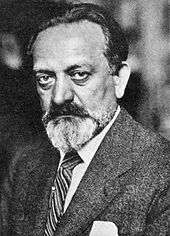
Life
Emil Orlik was the son of a tailor. He first studied art at the private art school of Heinrich Knirr, where one of his fellow pupils was Paul Klee. From 1891, he studied at the Munich Academy under Wilhelm Lindenschmit. Later he learned engraving from Johann Leonhard Raab and proceeded to experiment with various printmaking processes.[1]
After performing his military service in Prague, he returned to Munich, where he worked for the magazine Jugend. He spent most of 1898, travelling through Europe, visiting the Netherlands, Great Britain, Belgium, and Paris. During this time he became aware of Japanese art, and the impact it was having in Europe, and decided to visit Japan to learn woodcut techniques. He left for Asia in March 1900, stopping off in Hong Kong, before reaching Japan, where he stayed until February 1901.[1]
In 1905 Emil Orlik moved to Berlin and took a post at the "School for Graphic and Book Art" of the Museum of Decorative Arts (Kunstgewerbemuseum), now part of the Berlin State Museums. He taught at the Berlin College of Arts and Crafts, where one of his students was George Grosz.
Gallery
 Self portrait
Self portrait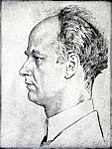 Wilhelm Furtwängler, conductor (1928)
Wilhelm Furtwängler, conductor (1928)
(etching with drypoint, printed with tone)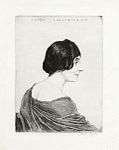 Wanda Landowska, harpsichordist (1917)
Wanda Landowska, harpsichordist (1917)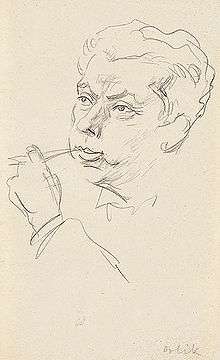 Max Reinhardt, theater and film director, and actor
Max Reinhardt, theater and film director, and actor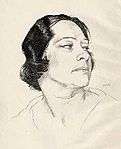 Tilla Durieux, Austrian actress (1922)
Tilla Durieux, Austrian actress (1922) Hans Wassmann as Nick Bottom (1909)
Hans Wassmann as Nick Bottom (1909)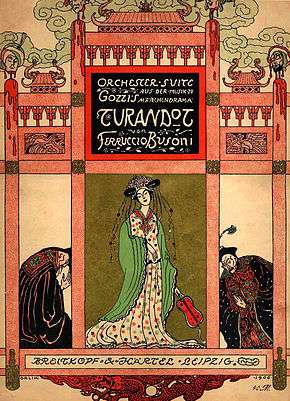
 Poster for the play Die Weber
Poster for the play Die Weber
by Gerhart Hauptmann (1897) Jakob Wassermann, novelist (1899)
Jakob Wassermann, novelist (1899)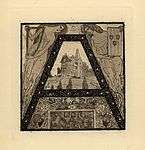 Bookplate for the books of Franz Anderle
Bookplate for the books of Franz Anderle_by_Emil_Orlik.jpg) Kout v mém ateliéru (Corner of My Studio), now hanging in the Czech National Gallery in Prague
Kout v mém ateliéru (Corner of My Studio), now hanging in the Czech National Gallery in Prague Gustav Mahler, composer, (1902)
Gustav Mahler, composer, (1902)- Richard Strauss, composer (1917)
 Kolo Moser, color woodcut, 18.2 × 18.5 cm, 1903
Kolo Moser, color woodcut, 18.2 × 18.5 cm, 1903
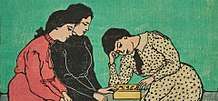
References
- Otterbeck, Cristoph (2007). Europa verlassen: Künstlerreisen am Beginn des 20. Jahrhunderts (in German). Weimar: Böhlau Verlag Köln. p. 80. ISBN 978-3-412-00206-0. Retrieved 15 December 2011.
External links
| Wikimedia Commons has media related to: |
- Works by or about Emil Orlík at Internet Archive
- Emil Orlik prints, books, artwork and biography
- Emil Orlik (1870–1932) - Portraits of Friends and Contemporaries [description of exhibition in 2004]. Jewish Museum in Prague (Czech Republic)
- Guide to the Emil Orlik Collection at the Leo Baeck Institute, New York.
- Newspaper clippings about Emil Orlík in the 20th Century Press Archives of the ZBW